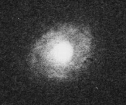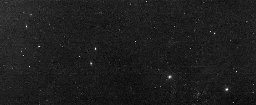Telescopes I've Used - My Nashville Roots
A 6-inch Newtonian reflector
 My first serious telescope was this 6-inch Dynascope from Criterion, which
seems to have outlasted the company. I got it secondhand in 1969 from the
husband of my junior-high algebra teacher (and I hereby
hoist a virtual glass to the memory of Clarence and Juanita McCanless).
I mowed about 40 yards that summer to pull this one off. I still
use it, joined about 15 years ago by a 10" Odyssey Dobsonian and
another 15 years later by a Celestron NexStar 5.
As you can see from the picture, the 6-inch gets educational use these days.
My first serious telescope was this 6-inch Dynascope from Criterion, which
seems to have outlasted the company. I got it secondhand in 1969 from the
husband of my junior-high algebra teacher (and I hereby
hoist a virtual glass to the memory of Clarence and Juanita McCanless).
I mowed about 40 yards that summer to pull this one off. I still
use it, joined about 15 years ago by a 10" Odyssey Dobsonian and
another 15 years later by a Celestron NexStar 5.
As you can see from the picture, the 6-inch gets educational use these days.
Itching to be a "real astronomer", I contacted the locals at Vanderbilt
University. Doug Hall got me started doing visual observations of
eclipsing variables; we published a visual light curve of EG
Cephei in the AAVSO Journal.
I also did lots of lunar observations (hey, the Apollo program was in
full swing at the time). I'm especially fond of the photo
showing Mare Orientale at unusually favorable libration. And I tried
my hand at photographing the bright planets as well, just getting to the
point where
I could record shadow transits of Jovian moons from the old back yard.
Somehow, though, going to college really cut into the time for such
pursuits. Still, there were compensations - the telescopes got
bigger.
Dyer Observatory
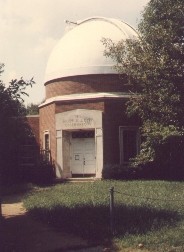 The primary instrument at Dyer Observatory, which is located on the
southern edge of Nashville, is the 61-cm (24") Seyfert telescope, which was
named for
Carl Seyfert to honor his role in the construction of both telescope and
observatory.
Using this telescope,
I started working with Doug Hall on mass-transfer binary stars, in a way
continuing the backyard studies that he had advised me on even before
I got to Vanderbilt. As an example, here's a light curve of U Cephei
from the photoelectric photometer on the Seyfert telescope, from the night of
3/4 October 1976. This system can change its mass transfer rate rapidly,
which is often reflected in the light curve - the accretion "hot spot"
can come and go, so that the eclipse can go from total to partial in
form within a couple of 2.5-day orbits. It was back to total in this
case, as seen from the flat bottom. The V magnitudes are differential
with respect to BD +81 27. The 61-cm Seyfert telescope has an interesting
convertible design, so it can be used as a classical Cassegrain or as
a Baker reflector-corrector wide-field photographic telescope.
As Rick Blakley at NOAO kindly pointed out, this is distinct from
the better-known Baker-Schmidt design, incorporating a doublet and
a corrector plate to reduce the coma inherent in the paraboloidal
primary of a Newtonian or classical Cassegrain system.
The primary instrument at Dyer Observatory, which is located on the
southern edge of Nashville, is the 61-cm (24") Seyfert telescope, which was
named for
Carl Seyfert to honor his role in the construction of both telescope and
observatory.
Using this telescope,
I started working with Doug Hall on mass-transfer binary stars, in a way
continuing the backyard studies that he had advised me on even before
I got to Vanderbilt. As an example, here's a light curve of U Cephei
from the photoelectric photometer on the Seyfert telescope, from the night of
3/4 October 1976. This system can change its mass transfer rate rapidly,
which is often reflected in the light curve - the accretion "hot spot"
can come and go, so that the eclipse can go from total to partial in
form within a couple of 2.5-day orbits. It was back to total in this
case, as seen from the flat bottom. The V magnitudes are differential
with respect to BD +81 27. The 61-cm Seyfert telescope has an interesting
convertible design, so it can be used as a classical Cassegrain or as
a Baker reflector-corrector wide-field photographic telescope.
As Rick Blakley at NOAO kindly pointed out, this is distinct from
the better-known Baker-Schmidt design, incorporating a doublet and
a corrector plate to reduce the coma inherent in the paraboloidal
primary of a Newtonian or classical Cassegrain system.
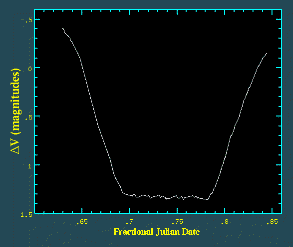
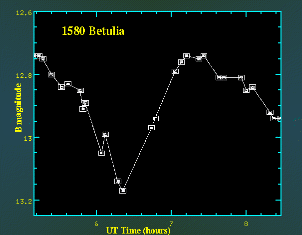 The first observations I got at Dyer were of moving targets, which
taught me a lesson. Here's a light curve of the Earth-approaching
asteroid 1580 Betulia, taken when it approached to about 0.13 AU
from us in May 1976. The apparent motion was fast enough to limit
how long it spent in the photometer's aperture, since there was no
declination drive available (this, a grazing occultation of Saturn, and
Comet Hyakutake are the only times I can recall actually seeing orbital
motion of natural objects). This asteroid has both shape and color
distributions that are complex, so it shows three maxima and minima per
6.1-hour rotation (these data were analyzed by Tedesco and Drummond in a
1978
Icarus paper). And my first Baker-Schmidt plates were also of a
moving target,
Comet West in the spring of 1976.
The first observations I got at Dyer were of moving targets, which
taught me a lesson. Here's a light curve of the Earth-approaching
asteroid 1580 Betulia, taken when it approached to about 0.13 AU
from us in May 1976. The apparent motion was fast enough to limit
how long it spent in the photometer's aperture, since there was no
declination drive available (this, a grazing occultation of Saturn, and
Comet Hyakutake are the only times I can recall actually seeing orbital
motion of natural objects). This asteroid has both shape and color
distributions that are complex, so it shows three maxima and minima per
6.1-hour rotation (these data were analyzed by Tedesco and Drummond in a
1978
Icarus paper). And my first Baker-Schmidt plates were also of a
moving target,
Comet West in the spring of 1976.
Eventually I wandered into galaxy studies, encouraged by Dan Weedman
(who's stayed mum about whether this was a good idea). He started me
on a photographic survey of bright galactic nuclei, the idea being
to see what the systematics of nuclear properties were with galaxy
type, tell whether there existed nuclei comparably bright to
recognized Seyferts, and identify interesting candidates for
followup (all of which were more important at the time than one would
imagine 20 years later). We used the Baker-Schmidt mode of the
Seyfert telescope, which gave a geometrically flat field at the same
image scale as the Burrell or Curtis Schmidts at NOAO, and giving a
field up to 5 degrees across. This survey ended up identifying
about 1300 galaxies, aided by an early application of the digital
RNGC catalog to map expected NGC objects for each plate at the right
scale. From 5-minute blue-light exposures, here are a few of the most
interesting nuclei from that survey (of which NGC 7714 certainly went
on to considerable fame). Specifically, they are NGC 4736 (M94), NGC 4826 (M64)
and the region of the Virgo cluster known as Markarian's Chain
(to the northwest of M87).
We identified 10 nuclei as being especially
interesting for being unusually bright and small, some of which
have attracted forther interest. This "top 10" list produced a few
other galaxies that have proven notable. Aside from NGC 7714, NGC 4569 seems
to have harbored a starburst which produced a bizarre number of A-type
supergiant stars in a tiny volume, from IUE and HST data; NGC 3504 and 4385 are
luminous barred starburst galaxies; and NGC 7769 has had a starburst
apparently triggered by interaction with NGC 7771. (For the really
curious, the ADS-scanned paper is
here).
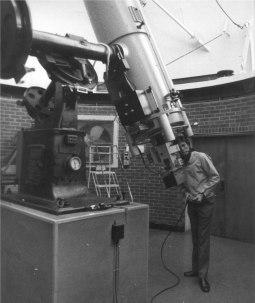 Dan also got Don Hamilton and me started following the variations of
Seyfert galaxies using both photoelectric and photographic techniques.
The telescope is demonstrated in this picture by a famous
astronomer, doing his Edwin Hubble impression at the eyepiece.
Dan also got Don Hamilton and me started following the variations of
Seyfert galaxies using both photoelectric and photographic techniques.
The telescope is demonstrated in this picture by a famous
astronomer, doing his Edwin Hubble impression at the eyepiece.
The observatory also hosts a 12-inch Cassegrain reflector built
by the late John De Witt Jr. (of
Project
Diana fame, the first detection of
radio waves reflected from the Moon in a
postwar US Army Signal
Corps project), originally used at his home.
The optical quality was quite nice, as seen from this Jupiter snapshot
which I had quite forgotten about for years.
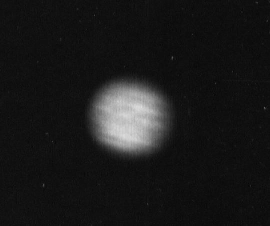
Telescope Collection
Bill Keel's Home Page |
Astronomical Image Gallery |
Image Usage and Copyright Info |
UA Astronomy
keel@bildad.astr.ua.edu
Last changes: 08/2005 © 1999
 My first serious telescope was this 6-inch Dynascope from Criterion, which
seems to have outlasted the company. I got it secondhand in 1969 from the
husband of my junior-high algebra teacher (and I hereby
hoist a virtual glass to the memory of Clarence and Juanita McCanless).
I mowed about 40 yards that summer to pull this one off. I still
use it, joined about 15 years ago by a 10" Odyssey Dobsonian and
another 15 years later by a Celestron NexStar 5.
As you can see from the picture, the 6-inch gets educational use these days.
My first serious telescope was this 6-inch Dynascope from Criterion, which
seems to have outlasted the company. I got it secondhand in 1969 from the
husband of my junior-high algebra teacher (and I hereby
hoist a virtual glass to the memory of Clarence and Juanita McCanless).
I mowed about 40 yards that summer to pull this one off. I still
use it, joined about 15 years ago by a 10" Odyssey Dobsonian and
another 15 years later by a Celestron NexStar 5.
As you can see from the picture, the 6-inch gets educational use these days.







